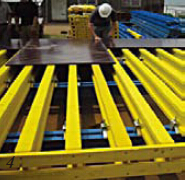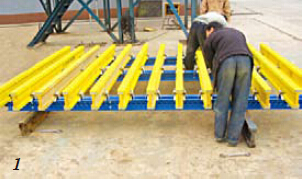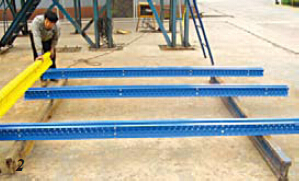Timber-Beam Plywood Formwork for building Construction
- Loading Port:
- Tianjin
- Payment Terms:
- TT OR LC
- Min Order Qty:
- 50 m²
- Supply Capability:
- 1000 m²/month
OKorder Service Pledge
Quality Product, Order Online Tracking, Timely Delivery
OKorder Financial Service
Credit Rating, Credit Services, Credit Purchasing
You Might Also Like
Plywood --- make perfect concrete surface
WISA-Form Birch is a coated special plywood using in the formwork systems where high
requirements are set on the concrete surface and the times of reuses.
With CNBM timber beam & WISA plywood, the formwork is low weight but high load capacity, it is
widely used in construction.
Characteristics:
◆ Component with high standardization.
◆ Assembling in site, flexible application.
◆ Light weight, easy transportation and storage.



- Q:Can steel formwork be used in areas with high wind loads?
- Yes, steel formwork can be used in areas with high wind loads. Steel formwork is known for its strength, durability, and stability, making it a suitable choice for construction projects in areas with high wind loads. The robustness and rigidity of steel formwork allow it to withstand the force and pressure exerted by strong winds, ensuring the safety and stability of the structure being built. Additionally, steel formwork offers a higher level of resistance to deformation and movement compared to other types of formwork materials, making it more reliable in areas prone to high wind loads. However, it is crucial to ensure that the steel formwork is properly secured and anchored to the ground to further enhance its resistance against wind loads.
- Q:How does steel formwork handle different concrete slump flow measurements?
- Steel formwork offers versatility and durability when dealing with various measurements of concrete slump flow. Slump flow is a gauge of concrete's consistency and workability, indicating its capacity to flow and fill the formwork. Designed to be rigid and robust, steel formwork can withstand the weight and pressure of poured and cured concrete. This ensures that it effectively contains and supports concrete with different slump flow measurements, preventing any deformation or failure. One advantage of steel formwork lies in its ability to easily adapt to changes in concrete slump flow. It can be adjusted or modified to accommodate varying levels of fluidity and workability. By tightening or loosening the formwork panels, the desired shape and size can be achieved, ensuring proper containment and shaping of the concrete, regardless of its slump flow measurement. Furthermore, steel formwork provides a smooth and uniform surface for the concrete, which is crucial for achieving a high-quality finish. The steel's rigid structure guarantees that the formwork remains in place during the pouring process, minimizing the risk of any movement or displacement that could negatively affect the concrete's performance and appearance. Additionally, steel formwork is resistant to moisture and chemicals, which are often present in concrete mixtures. This resistance ensures that the formwork remains in excellent condition even when exposed to different slump flow measurements, preventing any degradation or corrosion that could compromise its strength and stability. Overall, steel formwork proves to be a dependable and efficient choice for handling different measurements of concrete slump flow. Its strength, adaptability, and resistance to moisture and chemicals make it well-suited for containing and shaping concrete with varying levels of workability, ensuring successful construction projects.
- Q:Can steel formwork be used for dam construction projects?
- Indeed, dam construction projects can make use of steel formwork. This option proves to be both versatile and durable, capable of enduring the intense pressures and extreme conditions inherent in such projects. Its strength and stability allow for customization to meet the dam's specific design requirements. Moreover, steel formwork boasts a notable load-bearing capacity, enabling it to bear the weight of the concrete during the pouring and curing stages. Furthermore, it guarantees a smooth surface finish, thereby ensuring the concrete structure's quality and integrity. What's more, steel formwork can be reused, resulting in reduced costs and environmental impact throughout the construction endeavor. All in all, steel formwork proves to be a dependable and efficient choice for dam construction projects.
- Q:How does steel formwork contribute to improved construction site logistics?
- Steel formwork contributes to improved construction site logistics in several ways. Firstly, steel formwork is lightweight and easily movable, making it more convenient to transport and set up on-site. This reduces the time and effort required for assembling and dismantling formwork, leading to improved efficiency in construction site logistics. Secondly, steel formwork is durable and can be reused multiple times, minimizing the need for constant replacement. This not only saves costs but also reduces the amount of waste generated at the construction site, contributing to better waste management and environmental sustainability. Furthermore, steel formwork provides precise and accurate results, ensuring that the concrete structures being built are of high quality and meet the required standards. This helps in avoiding rework or corrections, which can cause delays in the construction process. Overall, the use of steel formwork in construction enhances the overall logistics of the site by improving transportation, reducing waste, and ensuring quality construction, ultimately leading to more efficient and successful projects.
- Q:Can steel formwork be used for pier caps?
- Yes, steel formwork can be used for pier caps. Steel formwork is a versatile and durable material that can easily be customized to fit the specific dimensions and design requirements of pier caps. It provides a strong support system for concrete pouring and helps in achieving accurate and precise shapes for pier caps. Additionally, steel formwork offers the advantage of being reusable, making it a cost-effective choice for construction projects.
- Q:Can steel formwork be used in bridge construction?
- Yes, steel formwork can be used in bridge construction. Steel formwork refers to the use of steel panels or frames to create the desired shape and structure of a bridge during the construction process. Steel formwork is often preferred in bridge construction due to its durability, strength, and ability to withstand the high loads and stresses that bridges are subjected to. It is capable of withstanding heavy concrete pouring and can be reused multiple times, making it a cost-effective choice for bridge construction. Additionally, steel formwork offers flexibility in design and allows for intricate and complex shapes to be constructed, ensuring the bridge meets the desired specifications and requirements. Overall, steel formwork is a popular choice in bridge construction due to its strength, durability, reusability, and versatility.
- Q:How does steel formwork handle concrete finishing and curing agents?
- Steel formwork, a material specifically designed for concrete finishing and curing, is highly durable and versatile. Its strength and rigidity ensure a stable structure for controlled pouring and curing of concrete. During the concrete finishing stage, steel formwork allows for the smooth and even application of various finishing agents like troweling, brushing, or spraying. The smooth surface of steel formwork facilitates easy application and manipulation of these agents, resulting in a uniform and aesthetically pleasing finish. Furthermore, steel formwork is resistant to chemical reactions with concrete curing agents. These curing agents, such as sealers, compounds, or coatings, enhance the strength, durability, and appearance of freshly poured concrete. Steel formwork's non-reactive nature allows for the application and absorption of these agents by the concrete without any negative impact on the formwork material. Moreover, steel formwork is non-absorbent, meaning it does not soak up moisture from curing agents or the concrete itself. This characteristic is vital during the curing process as it allows the concrete to maintain its moisture content, ensuring proper hydration and strength development. Additionally, the non-absorbent nature of steel formwork prevents potential damage or degradation that could arise from moisture absorption, expansion, or corrosion. In conclusion, steel formwork is an excellent choice for handling concrete finishing and curing agents due to its strength, rigidity, non-reactive nature, and non-absorbent properties. It provides a stable structure for applying finishing agents while supporting proper curing and moisture retention in the concrete.
- Q:Can steel formwork be used in hygienic or sterile environments?
- No, steel formwork is not suitable for use in hygienic or sterile environments as it can harbor bacteria and is difficult to clean and sanitize properly.
- Q:Can steel formwork be used for underwater concrete structures?
- Underwater concrete structures can indeed utilize steel formwork. The durability, strength, and ability to endure harsh environmental conditions are well-known attributes of steel formwork. When employed for underwater concrete structures, steel formwork supplies a dependable and stable framework for pouring and molding the concrete. It can endure the water's pressure and forces, ensuring precise containment and desired shaping of the concrete. Furthermore, steel formwork displays resistance to corrosion, a crucial factor in underwater environments where the probability of rusting is elevated. In summary, due to its strength, durability, and corrosion resistance, steel formwork proves to be an appropriate choice for underwater concrete structures.
- Q:Can steel formwork be used for foundation construction?
- Indeed, foundation construction can make use of steel formwork. Steel formwork proves to be a flexible and long-lasting alternative for the creation of foundations. It affords a solid and steady support system for the pouring of concrete and the achievement of the desired shape and structure of the foundation. Steel formwork presents various advantages, such as its easy assembly and disassembly, reusability, and capacity to withstand substantial loads and pressure. Moreover, steel formwork exhibits high resistance to moisture and can be effortlessly cleaned, rendering it suitable for application in foundation construction projects. All in all, steel formwork stands as a dependable and effective choice for the construction of foundations.
1. Manufacturer Overview |
|
|---|---|
| Location | |
| Year Established | |
| Annual Output Value | |
| Main Markets | |
| Company Certifications | |
2. Manufacturer Certificates |
|
|---|---|
| a) Certification Name | |
| Range | |
| Reference | |
| Validity Period | |
3. Manufacturer Capability |
|
|---|---|
| a)Trade Capacity | |
| Nearest Port | |
| Export Percentage | |
| No.of Employees in Trade Department | |
| Language Spoken: | |
| b)Factory Information | |
| Factory Size: | |
| No. of Production Lines | |
| Contract Manufacturing | |
| Product Price Range | |
Send your message to us
Timber-Beam Plywood Formwork for building Construction
- Loading Port:
- Tianjin
- Payment Terms:
- TT OR LC
- Min Order Qty:
- 50 m²
- Supply Capability:
- 1000 m²/month
OKorder Service Pledge
Quality Product, Order Online Tracking, Timely Delivery
OKorder Financial Service
Credit Rating, Credit Services, Credit Purchasing
Similar products
New products
Hot products
Related keywords























